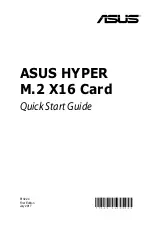
Appendix
APCIe-040
8
Appendix
8.1
Glossary
Change-over contact
A change-over contact is a contact
arrangement, with which a contact point
closes, when it is operated, as another contact
point opens. The change-over contact is
connected to the closing contact when the
relay is accessed and with the opening contact
in the rest position.
Closing contact
With a make or closing contact, a contact is
made after activation of the relay. When the
relay is no longer accessed, the contact is
opened again.
Data bus
The data bus basically consists of several lines
(or pins) through which the processor sends
and receives data. The volume of data that can
be transmitted simultaneously depends on the
number of data lines. In other words: The more
pins the bus has, the more efficient it is.
Direct current voltage
DC voltage means that the voltage remains
constant over time. In practice, it will always
exhibit small fluctuations. Particularly when
switching a device on or off, the transitional
behaviour may be of significance. Transient
oscillations may occur, determined by the
actual connection.
Driver
A driver is a series of software instructions
written specifically to manage particular
devices.
Edge
Edges can either be rising or falling.
Logic levels are defined for processing and
displaying information. In binary circuits,
voltages are used for digital values. Here, the
two voltage ranges “H” (high) und “L” (low)
represent the information.
The “H” range is closer to plus infinity; the “H”
level corresponds to digital 1. “L” denotes the
range closer to minus infinity; the “L” level
corresponds to digital 0. The rising edge is the
transition from the status “0” to “1”; the
falling edge is the opposite transition.
EMC
= Electromagnetic Compatibility
The definition of the VDE regulation 0870
states: Electromagnetic compatibility is the
ability of an electrical installation to function
satisfactorily within its electromagnetic
environment without unduly affecting its
environment and the equipment it contains.
ESD
= Electrostatic Discharge
On non-conductive surfaces, an electric charge
is conducted away very slowly. If the dielectric
strength is overcome, there is a fast potential
equalisation between the surfaces involved.
The often very sudden equalisation process is
referred to as electrostatic discharge (ESD).
Currents of up to 20 A may occur in this
process.
Ground line
Ground lines should not be seen as potential-
free return lines. Different ground points may
have small potential differences. This is always
true with large currents and may cause
inaccuracy in high-resolution circuits.
Input level
The input level is the logarithmic ratio between
two electrical values of the same type (voltage,
current or power) at the signal input of any
receiving unit. This unit is often configured as a
logical level related to the input of the circuit.
The input voltage corresponding to logic “0” is
between 0 V and 15 V and the voltage
corresponding to logic “1” is between 17 V and
30 V.
www.addi-data.com 28




































